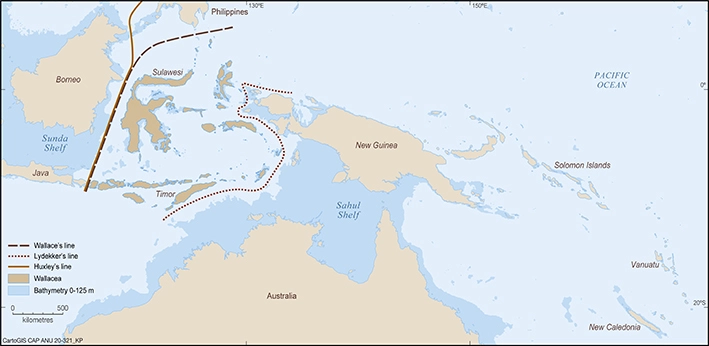Description

Copyright infringement not intended
Picture Courtesy: https://evolutionofculturaldiversity.anu.edu.au/our-research/peopling-sahul/
Context: Archaeologists unearthed Sahul, a supercontinent exposed by lower sea levels during the last ice age. This land bridge enabled human migration from Asia to Australia roughly 70,000 years ago.
Details
- Archaeologists have made an extraordinary discovery of a lost landscape called Sahul, which played a significant role in human migration from Asia to Australia around 70,000 years ago. This finding sheds new light on human history and migration patterns, revealing a supercontinent that was exposed during the last ice age.
What is Sahul?
- Sahul was a supercontinent that existed during the last ice age. During this period, extensive glaciation caused sea levels to drop, exposing landmasses that are now submerged.
- Sahul connected what is now Australia to Papua New Guinea in the north and Tasmania in the south. This land bridge facilitated the migration of ancient humans across continents.
Discovery and Significance
- The discovery of Sahul was made possible through advanced research techniques, including geological data analysis and environmental simulations.
- By reverse-engineering the conditions that existed between 75,000 and 35,000 years ago, researchers created a model of Sahul's landscape. This model helped identify two potential migration routes that ancient humans might have taken.

Migration Routes and Archaeological Evidence
- The simulations provided insights into how ancient humans moved across Sahul. Researchers used archaeological sites spread across the landscape to trace human movement. These sites offer evidence of when and where people migrated, revealing patterns of fast-paced movement in search of food and shelter under challenging conditions.
The discovery of Sahul is significant for several reasons
- Migration Patterns: It provides concrete evidence of human migration routes from Asia to Australia, enriching our understanding of early human dispersal.
- Archaeological Potential: The revelation of Sahul opens the possibility of discovering numerous other historic sites, which could further illuminate human history and prehistoric life.
- Geological and Environmental Insights: The study of Sahul offers a deeper understanding of the Earth's geological history and the environmental conditions of the last ice age.
Conclusion
- The unearthing of Sahul highlights the dynamic nature of Earth's history and the complexities of human migration. This lost landscape, now reconstructed through scientific simulations, provides invaluable insights into early human journeys and opens new avenues for archaeological discoveries. As scientists delve deeper into the mysteries of Sahul, they may unlock further secrets of our ancient world, offering a richer narrative of human existence and migration.
Source:
Economics Times
|
PRACTICE QUESTION
Q. Sahul, a term making headlines recently, refers to:
A) A newly discovered continent in the Arctic Ocean.
B) An ancient supercontinent that once existed where Australia is today.
C) A future landmass predicted by geologists.
D) A type of unique marine ecosystem.
Answer: B
|
















